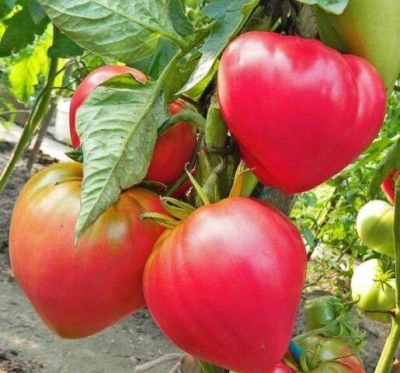
- Authors: breeding Siberia
- Appeared when crossing: based on the Shikoku variety
- Category: grade
- Appointment: for pickling and preserving
- Ripening period: mid-season
- Growing conditions: for open ground, for film greenhouses
- Marketability: high
- Bush size: undersized
- Bush height, cm: 60-80
- Foliage: weak
The Japanese rose tomato is the result of painstaking work of agricultural breeders from Siberia. This variety was based on the Shikoku variety. As a result of the crossing process, agricultural techniques have received a universal culture that can be cultivated in any climatic conditions. A harvest tomato can be grown both in greenhouse conditions and in the open field, and the mass ripening of fruits and their ability to ripen outside the plant make the variety in demand among both amateur gardeners and professionals. The unpretentiousness of the tomato and the ease of caring for it minimize the labor expended on growing.
Description of the variety
Tomatoes of the Japanese rose variety belong to undersized determinant species that give a high yield both in greenhouse conditions and in open beds. Plant height ranges from 60 cm to 80 cm. The low bushes have a branched crown and a powerful root system. Pickling is a must for this variety. Small leaf plates do not cover the entire surface of the stems. Due to its size, the plant does not need to be fixed to a vertical support. This variety is capable of forming up to 6 fruits on one bunch.
Advantages:
unpretentiousness;
the presence of a juicy and sugary structure with a minimum amount of acidity;
high productivity;
immunity to the most common diseases;
no need for fixation;
long storage period without loss of taste;
insignificant seed chambers;
transportability.
This variety has no obvious drawbacks, but you can get the maximum yield and strong bushes only with strict adherence to all the rules of agricultural technology.
The main qualities of the fruit
The fruits of this variety are large in size with a weight of about 200 grams, as well as a rounded heart-shaped shape with a pointed end. The color range of tomatoes at the stage of technical ripeness ranges from deep pink to raspberry. The thick leathery cover of the fruit is practically not prone to cracking. This property has a positive effect on the shelf life, which can be up to 2 months, and transportability. The peduncle is convex-ribbed. Tomatoes have a small number of seed compartments.
The vitamin and mineral composition of tomatoes has a rich structure. This property is especially in demand in the dietary and children's diet. It should also be noted that cooked dishes have a low degree of allergenicity.
Taste characteristics
This variety has a juicy and fleshy texture. Taste indicators are excellent, and even gourmets will like the sweetish aftertaste. Due to their high taste characteristics, tomatoes are successfully used both for fresh consumption and for canning.
Ripening and fruiting
The plant belongs to mid-season crops with mass ripening of fruits. The first harvest is carried out as early as 110-115 days after the appearance of the first shoots.
Yield
The Japanese rose tomato belongs to high-yielding varieties, capable of forming up to 8 kg of yield on one bush. The average weight of fruits on one bush is 5-6 kg.
The timing of planting seedlings and planting in the ground
This crop is grown in seedlings.Sowing seeds for seedlings is carried out in early March. Seed material must be treated with disinfectants and growth stimulants before planting. Germination can be increased by creating a greenhouse effect. The soil for planting should consist of turf, sand and mineral fertilizers. When planting, the seeds are buried 15 mm, observing an interval of 50 mm between them.
The pick is carried out in the phase of formation of the first 2-3 leaves. In early May, mature seedlings can be planted in open ground. In regions where the threat of night frosts still persists, planting should be postponed until mid-May, or film shelters should be used.

Growing tomato seedlings is an extremely important process, because it largely depends on whether the gardener can harvest at all. All aspects must be taken into account, from seedbed preparation to planting in the ground.
Landing scheme
The planting scheme of the variety is practically no different from the rest of the nightshade. On a plot of 1 m2, practicing breeders recommend planting no more than 3 bushes. When planting seedlings, one should not forget that adult bushes have a spreading crown, for the development of which space is required.

Growing and caring
Despite the unpretentiousness of the variety, in order to obtain a stable and high-quality harvest, it is imperative to study all the intricacies of caring for it when growing tomatoes. The formation of a bush should be carried out in no more than 2 stems, the removal of all processes will maximize the enrichment of the fruits with all micronutrients. Passionking is carried out before the appearance of the first brush. Tomatoes, especially during the fruiting period, need abundant watering with settled water. The variety is responsive to the application of mineral and organic fertilizers.




A plant needs different micronutrients at each stage of growth. All fertilizers can be divided into two groups: mineral and organic. Folk remedies are often used: iodine, yeast, bird droppings, eggshells.
It is important to observe the rate and period of feeding. This also applies to folk remedies and organic fertilizers.
Disease and pest resistance
This variety has a high degree of resistance to diseases such as late blight and fusarium, however, to prevent the appearance of these diseases, preventive treatments with special means are necessary.



























































































